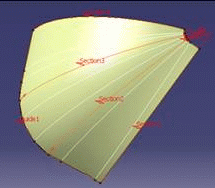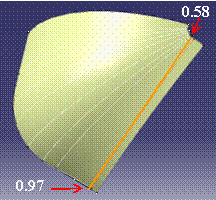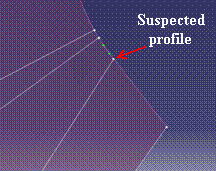How to create a swept surface when the center curve is neither continuous
in tangency nor planar?
|
 |
| In the Swept Surface Definition dialog box, the "Deviation
from Guide"
option defines the gap authorized between the guide curve and the swept
surface. With the default option, there is no gap. When this option is
activated, the sweep algorithm tries to generate a surface that does not
necessarily stick to the guide curve but is of better quality or enables
the completion of the sweep operation. The "Angular
Correction"
option is related to the angular tolerance of the moving frame (that is the
plane that moves perpendicularly along the guide curve). |
|
Here is an example of a swept surface with a reference
surface and a guide curve that is not continuous in tangency.
The discontinuities are located at the face junction on the reference
surface. You can use the Curve Smooth command
to check the guide curve continuity. |
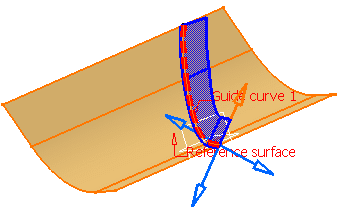 |
Workarounds
|
Apart from specifying a new guide curve (either continuous
in tangency or planar), you can:
-
Check the "Deviation
from guide"(s)
option in the Swept Surface Definition dialog box. That way, you
authorize a gap between the guide curve and the sweep itself. But the
generated sweep will not stick to the guide curve.
-
Check the "Angular
correction"
option. It is related to the angular tolerance of the moving frame (that
is the plane that moves perpendicularly along the guide curve) and also
has an effect on normal evaluation if there is an angular constraint on a
support along guides (for instance, a sweep line with reference surface).
- Smooth the guide curve. If you intend to create a sweep with a
reference surface, you must specify the reference surface as support in
the Curve Smooth Definition dialog box.
For further information, refer to Smoothing
Curves.
|
How to create a swept surface when the extrusion of the vertex of the profile
leads to a cusp?
|
 |
| When creating a multi-profile sweep, the parameters
affecting the resulting surface are the shape of the profiles, their number
and the way they are positioned, the guide curvature, etc. In the example
below, the sweep is twisted because it is over-constrained by two many
profiles. |
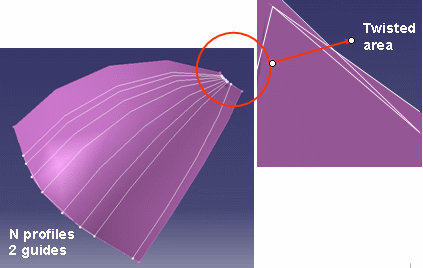 |
| |
Workarounds
|
- Reduce the number of sections: the less the surface is constrained,
the lower are the chances to generate a twisted surface.
- Search for an internal section with a disproportionate coupling along
the guides. This section is to be removed. Here, the length ratios for
the highlighted profile are respectively 0.58 and 0.97.
- Locate the twisted areas and search for the profiles in the
neighborhood of the retrieved vertices. Remove these profiles from the
list of profiles.
|
|
|
|
For further details about
swept surfaces, refer to Creating Swept Surfaces. |


